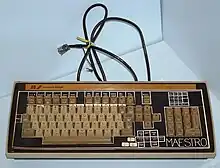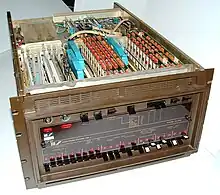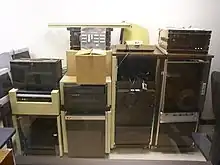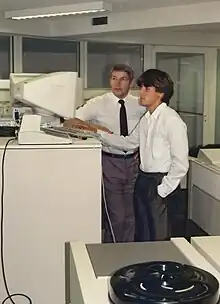
Maestro I[1] was an early integrated development environment for software.[2][3] developed by Softlab Munich in the 1970s and 1980s.
The system was originally called "Programm-Entwicklungs-Terminal-System" ("program development terminal system") abbreviated as PET; it was renamed after Commodore International introduced a home computer called the Commodore PET in 1977.
At one time there were 22,000 installations worldwide. The first USA installations were at Boeing in 1979, with eight Maestro I systems and Bank of America with 24 system and 576 developer terminals.[4] Until 1989, there were 6,000 installations in the Federal Republic of Germany .

One of the last Maestro I systems is at the Museum of Information Technology at Arlington.[6]
Origins

Early programming processes relied on entering code and test data in paper tape or punched cards. After finishing the punching, the programmer would feed the tape and/or the cards in the computer. The introduction of the IBM 3270 terminals together with IBM’s ISPF (Interactive System Productivity Facility) constituted a real improvement. The text editor that was integrated in ISPF allowed source code for programs to be entered in real time. The editor was controlled with commands, line editing and function keys. ISPF required entering code a page at a time, decreasing the immediacy of feedback; Maestro aimed to solve this by feeding each keystroke directly to the CPU.
Harald Wieler, copartner of Softlab Munich, developed the first prototype of the system, then named PET, in 1974, based on the Philips X1150 data collection system, originally a Four-Phase Systems IV/70 from the USA. Wieler was previously the architect of the operating system development for mainframes for Radio Corporation of America and Siemens. The development of Maestro was co-funded by the German government, with the objective of creating a hardware and software programming tool rentable for 1000 Deutsche Mark a month, about the same as a one family house in the Munich area at the time.
The first US customer was the Boeing Company, the aerospace and Defense Corporation with 7 systems. The biggest purchaser became the Bank of America who ordered 24 Maestro-computers with 576 terminals for its 10.000 programmers in their San Francisco computing center. Softlab founded a US branch which sold about 100 Maestro systems with some 2000 terminals in the US.[7]
Technology


Hardware
The basic system was a "key-to-disc" data entry system. Historical predecessors were "key-to-tape" systems such as the Mohawk Data Recorder, Olympia Multiplex 80 and Philips X1100.
Maestro used the Philips (Apeldoorn, the Netherlands) X1150 Data Entry system, which was built on a Four-Phase (Cupertino, California) IV/70 processor.
A typical configuration at the time of introduction was:
- System with 96-192 KB RAM
- 6-24 (dumb) terminals
- 10- 80 MB disc
- Magnetic tape
- Line printer (various types and models were supported)
- Data communication connection
The hardware evolved over time: the Four-Phase IV/70 processor was replaced by the more powerful Four-Phase IV/90 system and more terminals, memory and disc capacity could be supported. The base Philips X1150 Data Entry system was rebranded as Philips P7000 Distributed Processing System as significant additional functionality was added.

As the Maestro I user-base continued to grow, there was a limit to the number of available Philips P7000 and P7200 systems to satisfy demand. So, circa 1985, Softlab co-founder Harold Wieler asked Chris Dolezalek to port Maestro over to the Philips P7300. The P7300 leveraged the same instruction set, but had a new architecture which led it having a different boot sequence and interrupt handling. Dolezalek decided to detect the system architecture on boot and then using dynamic code, the system would move the appropriate code into place for either the P7000/P72000 or the P7300. This allowed Softlab to continue with the same code base for all three systems. To further extend the life of Maestro I, Dolezalek helped add the ability to connect a Unix file server to the Philips systems. This included the ability to create, modify and view hypertext markup language files that were stored on the file server. This browser/editor of local hyper-text files was one of the forerunners to the HTML web browser. Dolezalek, along with Géza Gerhardt, was also part of the team that later created Maestro II which ran in a client/server architecture with PC clients and Unix servers leveraging an object oriented database using UDP/IP to communicate.
Software
The operating system was a proprietary Four-Phase Disc Operating System (rebranded by Philips) which supported the usual components at that time: text editor, assembler, various compilers, and linkage editor.
The Four-Phase software offer consisted of packages for:
- Data Entry (key-to-disc)
- 3270 emulation
- 3270 emulation with programming facilities
- This unique package allowed the user to include local programming to off-load the mainframe
- COBOL
The original PET/Maestro software made extensive use of existing libraries from the above packages.
Softlab also provided, with Maestro, a "Programiersprache" to allow its users to write scripts to run on Maestro. These scripts were a simple way to put repeatable logic around a sequence of keystrokes. When the scripts were run, they'd fire keystrokes and the system would behave as though they had been manually pressed on a keyboard. Beyond that, when asked what languages Maestro supports, co-founder Harold Wieler replied: "What languages does your telephone support?" It could be tailored to support many computer languages (COBOL, FORTRAN, PLIl, etc.) and to serve mainframes of many brands and nationalities' ("IBM, ICL, Honeywell Bull...)."
Maestro also included an optional package called PLUS that would support various software development methodologies popular at the time.
References
- ↑ "Integrated development environment - Integration of Computers | Wiki eduNitas.com". edunitas.com. Retrieved 2023-07-29.
- ↑ Computerwoche: Interaktives Programmieren als Systems-Schlager Archived 2008-12-21 at the Wayback Machine, 1975/47
- ↑ "Integrated development environment - Integration of Computers | Wiki eduNitas.com". edunitas.com. Retrieved 2023-07-29.
- ↑ Der Spiegel, 17 January 1983, Page 71 Akten auf Knopfdruck
- ↑ Image credit: Museum of Information Technology at Arlington http://mit-a.com/fourphase.shtml
- ↑ Image credit: The Museum of Information Technology at Arlington - Four Phase IV/90
- ↑ Der Spiegel, Jan. 17, 1983, page 71
External links
- Christiane Floyd https://web.archive.org/web/20071018125442/http://swt-www.informatik.uni-hamburg.de/people/cfl.html
- Peter Schnupp to the story of Maestro I
- IEEE History Center: Ernst Denert Interview (29 June 1993)
- Datamation magazine: The Push for Productivity, Page 86 "Maestro is the godfather of all the front-end programming· environments and is based on a deliberate inquiry into the needs of programmers..." (15 August 1984)
- - Museum of Information Technology at Arlington - Four Phase
- Four Phase System a multi-terminal display- processing system